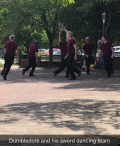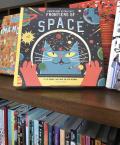Monday, July 31, 2017
By:
Following a sword dancing team can be difficult until it starts raining. And running in a library is frowned upon until it’s an after-hours scavenger hunt in the Library of Congress. It’s still frowned upon then, too.
Cutesy homes and shops stood along the tiny, twisty streets with rainbow windmills and other eclectic yard decor. The corner hosted a park with both a kiddy jungle gym, and a gazebo in an open space shaded by trees gnarled with time. A wall across the street sported iridescent tiles of the sun, stars, and celtic designs. In the sweltering heat, a group of six people in maroon shirts emerged from a small crowd. As the music from an accordion drifted on lethargic drafts of wind, the group began slowly skipping in a circle and waving swords. They sped up and followed intertwining paths and danced with their swords passing between performers. It was quite the sight, and the crowd clapped when the swords ended up in an entangled final resting position.
This is the sword dancing team, Cutting Edge, of which Ted Hodapp is a member. Ted, who also works at APS, sent us Cutting Edge’s busy Saturday schedule where they moved locations to perform. However, as the day progressed, it began raining, and we all ended up at a German bar to escape the downpour. Ted explained that the swords that look like they are made of flexible plastic during the performance are actually annealed spring steel with wooden handles that he made by hand. Quite impressive.
Tuesday was an after-hours scavenger hunt in the Library of Congress. Since I hadn’t been there yet, it was a clever, fun way for us to learn about its history and purpose. We even got to go into the main reading room and take pictures, which is normally not allowed while there are researchers in there.
The Startup Stories are starting to show up on the Physics Innovation and Entrepreneurship (PIE) Education page on the APS website. I have personally had phone interviews and written profiles for Brian Andrews, Joe Meyers, Nathan Swift, and Tracee Walker Gilbert. Nathan’s profile even got converted and published on The Vector, a physics undergraduate monthly email. Finding people to interview and getting people to respond on email probably proved to be the most difficult part of this project. However, I was able to go to enough relevant events and use my networking skills, which is how I was connected to Tracee.
Interviewing each of these people has increased my respect for entrepreneurs by orders of magnitude. It takes a lot of perseverance, dedication, and passion to continue what they are working on for years while working other jobs. It almost calls to question how to build such grit and resilience. Is it something that comes naturally to some people, or is it built up over years of pushing past life’s obstacles? As someone who has spent some time studying how to build resilience in students, through PAL at my school, I’ve asked myself whether it’s due to nature or nurture, the ultimate psychological question. Personally, I think nature has little to do with it, and that a person’s experiences make them stronger.
Mary Ann Mort







